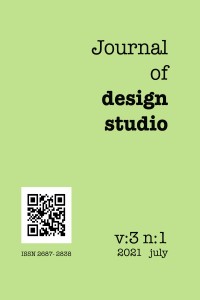Abstract
This paper presents a critical assessment of an interior design studio that was constructed face-to-face then online as an extended studio environment through spatial and technological means. In the Interior Design Studio III, students were expected to design an experiential retail store aiming at answering the contemporary customer and brand interactive experience. The concept of ‘interactive experience’ was central not only in terms of a project outcome but also of the studio process: an experiential learning environment is designed to enhance the understanding of the design studio. Within this scope, the collaboration with the maker lab of the university provided technological interfaces and analog model making methods while also expanding the limits of studio space. The interactive experience would not only result in the project outcome but also be integrated to the studio model. This studio model and the topic was conducted face-to-face in the campus three semesters consecutively, while the following two were held online. The study is based on exploratory research using qualitative techniques to analyze the design process of the students in the face-to-face and online experiential learning environment. The main objective is to overview and assess the interior design studio by providing a new perspective to the students about space and user relationship regarding interaction and atmosphere not only in terms of the given design problem but also the ‘environment’ they are experiencing the ways of design.
Keywords
Interior design studio Interactive experience Experiential retail design Extended learning environment
Thanks
We would like to thank all the participating students and the OpenFab for their collaboration.
References
- Akin, O., (2002). Case-based instruction strategies in architecture. Design Studies, 23, 407–431. https://doi.org/10.1016/s0142-694x(01)00046-1
- Bagdare, S., Rajnish J., (2013). Measuring Retail Customer Experience. International Journal of Retail and Distribution Management, 41 (10), 790–804. https://doi.org/10.1108/IJRDM-08-2012-0084.
- Brakus, J. J., Schmitt B., Zarantonello, L., (2009). Brand Experience: What Is It? How Is It Measured? Does It Affect Loyalty?., Journal of Marketing, 73 (3), 52–68. https://doi.org/10.1509/jmkg.73.3.52.
- Cachero-Martínez, S., Vázquez-Casielles, R., (2017). Living Positive Experiences in Store: How It Influences Shopping Experience Value and Satisfaction?, Journal of Business Economics and Management, 18 (3), 537–53. https://doi.org/10.3846/16111699.2017.1292311.
- Ceylanlı, Z. & Aktaş Yanaş, E., (2019). İç Mimarlık Tasarım Stüdyosunda Etkileşimli Mekân ve Deneyimsel Mağaza Tasarımı (Interactive space and experiential retail design in the interior architecture design studio). Türkiye’deki İç Mimarlık Eğitiminin Tarihi, Gelişimi ve Geleceği Ulusal Sempozyumu 19-21 Aralık 2019, İTÜ Mimarlık Fakültesi, Taşkışla. (paper presentation)
- Ciolfi, L., (2004). Understanding Spaces as Places: Extending Interaction Design Paradigms. Cognition, Technology & Work 6 (1), 37–40. https://doi.org/10.1007/s10111-003-0139-6.
- Fleischmann, K., (2019). From studio practice to online design education: Can we teach design online?. Canadian Journal of Learning and Technology, 45 (1), 1-18.
- Forest, C. R.; Moore, R. A.; Jariwala, A. S.; Burks Fasse, B.; Linsey, J.; Newstetter, W.; Ngo, P. & Quintero, C., (2014). The Invention Studio: A University Maker Space and Culture. Advances in Engineering Education, 4 (2), 1-32.
- Helmefalk, M., (2019). Browsing Behaviour as a Mediator: The Impact of Multi-Sensory Cues on Purchasing, Journal of Consumer Marketing, 36 (2), 253–63. https://doi.org/10.1108/JCM-10-2017-2392
- Hynes, M. M. & Hynes, W. J., (2018). If you build it, will they come? Student preferences for Makerspace environments in higher education. International Journal of Technology and Design Education, 28(3), 867-883. ttps://doi.org/10.1007/s10798-017-9412-5
- Hornecker, E., (2011). The Role of Physicality in Tangible and Embodied Interactions. Interactions, 18 (2), 19–23. https://doi.org/10.1145/1925820.1925826
- Imrie, R., (2003). Architects’ Conceptions of the Human Body. Environment and Planning D: Society and Space, 21 (1), 47–65. https://doi.org/10.1068/d271t
- Ioannou, O., (2018). Opening up design studio education using blended and networked formats. International Journal of Educational Technology in Higher Education, 15: 47. https://doi.org/10.1186/s41239-018-0129-7
- Masdeu, M. & Fuses, J., (2017). Reconceptualizing The Design Studio in Architectural Education: Distance Learning and Blended Learning as Transformation Factors. Archnet-IJAR: International Journal of Architectural Research, 11(2), 6-23. https://doi.org/10.26687/archnet-ijar.v11i2.1156
- Mallgrave, H. F., (2010). The Architect’s Brain: Neuroscience, Creativity, and Architecture, John Wiley & Sons, Ltd., Publication, ISBN: 978-1-405-19585-0
- Oxman, R., (1990) Prior knowledge in design: a dynamic knowledge-based model of design and creativity. Design Studies, 11 (1), 17-2. https://doi.org/10.1016/0142-694x(90)90011-z
- Oxman, R., (2004). Think-maps: teaching design thinking in design education. Design Studies, 25, 63-91. https://doi.org/10.1016/s0142-694x(03)00033-4
- Pallasmaa, J., (2014). Space, Place, and Atmosphere: Peripheral Perception in Existential Experience. In C. Borch (Ed.), Architectural Atmospheres (pp. 18-41). Berlin, Boston: Birkhäuser. https://doi.org/10.1515/9783038211785.18
- Schmitt, B., (1999). Experiential Marketing. Journal of Marketing Management, 15 (1–3), 53-67. https://doi.org/10.1362/026725799784870496.
- Schmitt, B., (2003). Customer experience management: A revolutionary approach to connecting with your customer. New York, NY: John Wiley & Sons.
- Schmitt, B., (2010). Experience Marketing: Concepts, Frameworks and Consumer Insights. Foundations and Trends in Marketing, 5(2), 55–112. https://doi.org/10.1561/1700000027
- Scupelli, P.; Candy, S. & Brooks, J., (2019). Teaching Futures: Trade-offs Between Flipped Classroom and Design Studio Course Pedagogies. International Association of Societies of Design Research Conference 2019 Proceedings.
- Servais, E., Leroi-Werelds S., Katelijn Q. & Jan V., (2018). “Conceptualizing The Value Of Physical Retailers: Comparing Marketing And Retail Design Perspectives”. Paper presented at the 4th International Colloquium on Design, Branding and Marketing, Hasselt University, Belgium.
- Quartier, K., Stephanie C., Jan V., (2019). A Holistic Competence Framework for (Future) Retail Design and Retail Design Education, Journal of Retailing and Consumer Services, https://doi.org/10.1016/j.jretconser.2019.101914.
- Verhoef, P. C., Katherine N. L., Parasuraman, A., Roggeveen A., Tsiros M., Schlesinger, L.A., (2009). Customer Experience Creation: Determinants, Dynamics and Management Strategies. Journal of Retailing 85 (1), 31–41. https://doi.org/10.1016/j.jretai.2008.11.001
- Vyas, D., van der Veer, G. & Nijholt, A., (2013). Creative practices in the design studio culture: collaboration and communication. Cognition, Technology & Work, 15, 415-443. https://doi.org/10.1007/s10111-012-0232-9
- Yakhlef, A., (2015). Customer Experience within Retail Environments: An Embodied, Spatial Approach. Marketing Theory, 15 (4), 545–64. https://doi.org/10.1177/1470593115569016.
Abstract
References
- Akin, O., (2002). Case-based instruction strategies in architecture. Design Studies, 23, 407–431. https://doi.org/10.1016/s0142-694x(01)00046-1
- Bagdare, S., Rajnish J., (2013). Measuring Retail Customer Experience. International Journal of Retail and Distribution Management, 41 (10), 790–804. https://doi.org/10.1108/IJRDM-08-2012-0084.
- Brakus, J. J., Schmitt B., Zarantonello, L., (2009). Brand Experience: What Is It? How Is It Measured? Does It Affect Loyalty?., Journal of Marketing, 73 (3), 52–68. https://doi.org/10.1509/jmkg.73.3.52.
- Cachero-Martínez, S., Vázquez-Casielles, R., (2017). Living Positive Experiences in Store: How It Influences Shopping Experience Value and Satisfaction?, Journal of Business Economics and Management, 18 (3), 537–53. https://doi.org/10.3846/16111699.2017.1292311.
- Ceylanlı, Z. & Aktaş Yanaş, E., (2019). İç Mimarlık Tasarım Stüdyosunda Etkileşimli Mekân ve Deneyimsel Mağaza Tasarımı (Interactive space and experiential retail design in the interior architecture design studio). Türkiye’deki İç Mimarlık Eğitiminin Tarihi, Gelişimi ve Geleceği Ulusal Sempozyumu 19-21 Aralık 2019, İTÜ Mimarlık Fakültesi, Taşkışla. (paper presentation)
- Ciolfi, L., (2004). Understanding Spaces as Places: Extending Interaction Design Paradigms. Cognition, Technology & Work 6 (1), 37–40. https://doi.org/10.1007/s10111-003-0139-6.
- Fleischmann, K., (2019). From studio practice to online design education: Can we teach design online?. Canadian Journal of Learning and Technology, 45 (1), 1-18.
- Forest, C. R.; Moore, R. A.; Jariwala, A. S.; Burks Fasse, B.; Linsey, J.; Newstetter, W.; Ngo, P. & Quintero, C., (2014). The Invention Studio: A University Maker Space and Culture. Advances in Engineering Education, 4 (2), 1-32.
- Helmefalk, M., (2019). Browsing Behaviour as a Mediator: The Impact of Multi-Sensory Cues on Purchasing, Journal of Consumer Marketing, 36 (2), 253–63. https://doi.org/10.1108/JCM-10-2017-2392
- Hynes, M. M. & Hynes, W. J., (2018). If you build it, will they come? Student preferences for Makerspace environments in higher education. International Journal of Technology and Design Education, 28(3), 867-883. ttps://doi.org/10.1007/s10798-017-9412-5
- Hornecker, E., (2011). The Role of Physicality in Tangible and Embodied Interactions. Interactions, 18 (2), 19–23. https://doi.org/10.1145/1925820.1925826
- Imrie, R., (2003). Architects’ Conceptions of the Human Body. Environment and Planning D: Society and Space, 21 (1), 47–65. https://doi.org/10.1068/d271t
- Ioannou, O., (2018). Opening up design studio education using blended and networked formats. International Journal of Educational Technology in Higher Education, 15: 47. https://doi.org/10.1186/s41239-018-0129-7
- Masdeu, M. & Fuses, J., (2017). Reconceptualizing The Design Studio in Architectural Education: Distance Learning and Blended Learning as Transformation Factors. Archnet-IJAR: International Journal of Architectural Research, 11(2), 6-23. https://doi.org/10.26687/archnet-ijar.v11i2.1156
- Mallgrave, H. F., (2010). The Architect’s Brain: Neuroscience, Creativity, and Architecture, John Wiley & Sons, Ltd., Publication, ISBN: 978-1-405-19585-0
- Oxman, R., (1990) Prior knowledge in design: a dynamic knowledge-based model of design and creativity. Design Studies, 11 (1), 17-2. https://doi.org/10.1016/0142-694x(90)90011-z
- Oxman, R., (2004). Think-maps: teaching design thinking in design education. Design Studies, 25, 63-91. https://doi.org/10.1016/s0142-694x(03)00033-4
- Pallasmaa, J., (2014). Space, Place, and Atmosphere: Peripheral Perception in Existential Experience. In C. Borch (Ed.), Architectural Atmospheres (pp. 18-41). Berlin, Boston: Birkhäuser. https://doi.org/10.1515/9783038211785.18
- Schmitt, B., (1999). Experiential Marketing. Journal of Marketing Management, 15 (1–3), 53-67. https://doi.org/10.1362/026725799784870496.
- Schmitt, B., (2003). Customer experience management: A revolutionary approach to connecting with your customer. New York, NY: John Wiley & Sons.
- Schmitt, B., (2010). Experience Marketing: Concepts, Frameworks and Consumer Insights. Foundations and Trends in Marketing, 5(2), 55–112. https://doi.org/10.1561/1700000027
- Scupelli, P.; Candy, S. & Brooks, J., (2019). Teaching Futures: Trade-offs Between Flipped Classroom and Design Studio Course Pedagogies. International Association of Societies of Design Research Conference 2019 Proceedings.
- Servais, E., Leroi-Werelds S., Katelijn Q. & Jan V., (2018). “Conceptualizing The Value Of Physical Retailers: Comparing Marketing And Retail Design Perspectives”. Paper presented at the 4th International Colloquium on Design, Branding and Marketing, Hasselt University, Belgium.
- Quartier, K., Stephanie C., Jan V., (2019). A Holistic Competence Framework for (Future) Retail Design and Retail Design Education, Journal of Retailing and Consumer Services, https://doi.org/10.1016/j.jretconser.2019.101914.
- Verhoef, P. C., Katherine N. L., Parasuraman, A., Roggeveen A., Tsiros M., Schlesinger, L.A., (2009). Customer Experience Creation: Determinants, Dynamics and Management Strategies. Journal of Retailing 85 (1), 31–41. https://doi.org/10.1016/j.jretai.2008.11.001
- Vyas, D., van der Veer, G. & Nijholt, A., (2013). Creative practices in the design studio culture: collaboration and communication. Cognition, Technology & Work, 15, 415-443. https://doi.org/10.1007/s10111-012-0232-9
- Yakhlef, A., (2015). Customer Experience within Retail Environments: An Embodied, Spatial Approach. Marketing Theory, 15 (4), 545–64. https://doi.org/10.1177/1470593115569016.
Details
| Primary Language | English |
|---|---|
| Subjects | Other Fields of Education |
| Journal Section | Research Articles |
| Authors | |
| Publication Date | July 20, 2021 |
| Published in Issue | Year 2021 Volume: 3 Issue: 1 |
This work is licensed under a Creative Commons Attribution 4.0 International License.
The articles published in Journal of Design Studio had been similarity checked by intihal.net

CALL FOR ARTICLES
Journal of Design Studio call for research papers on studios in all disciplines. Please submit your article by using Dergipark online submission system.



